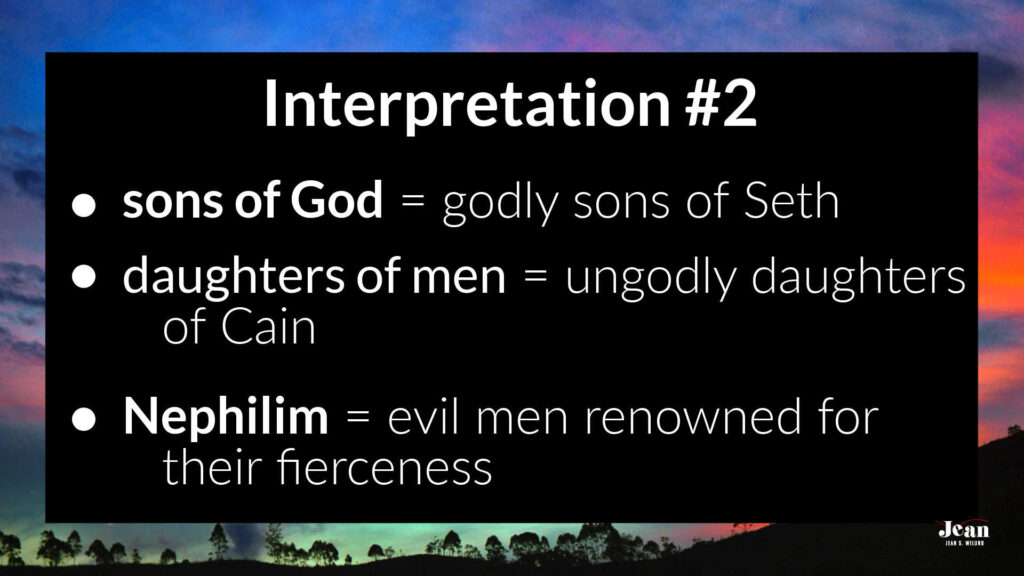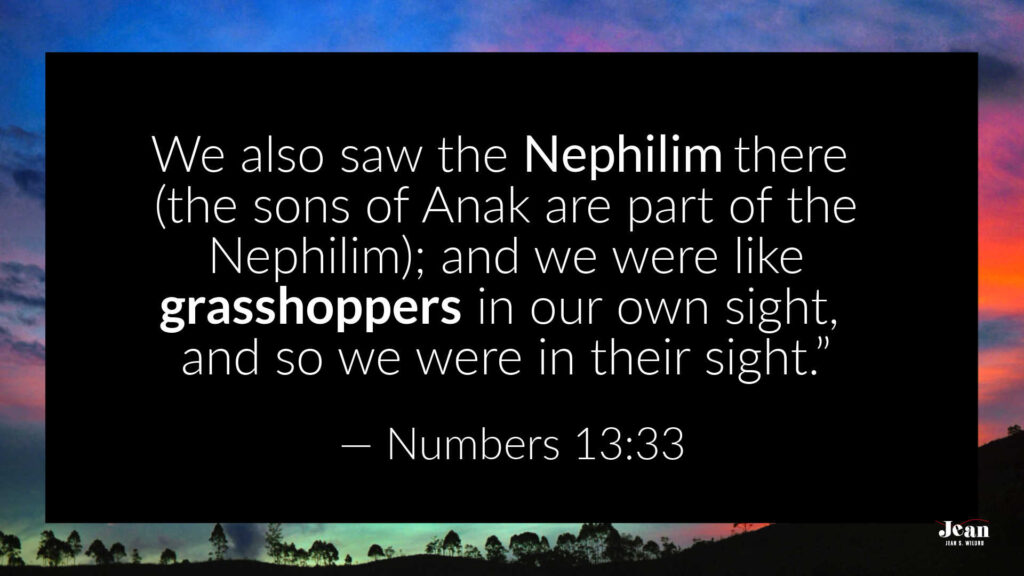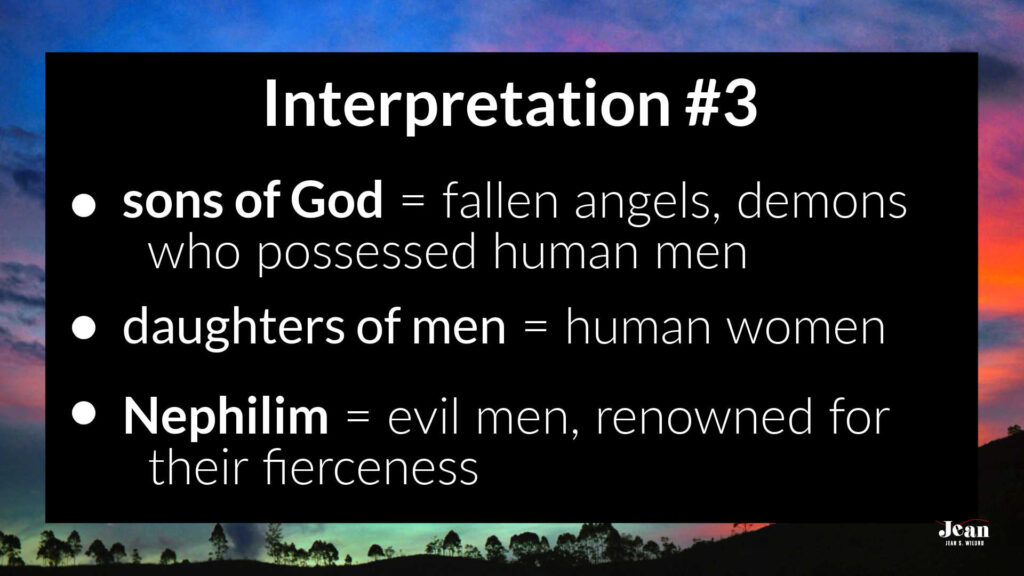Confused From the Start in Genesis 6
We’re in Genesis 6 now, and it starts out a bit confusing. Who are the “sons of God,” the “daughters of men,” and the “Nephilim” in Genesis 6?
If we were an Israelite in the days when Moses wrote Genesis, we wouldn’t need an explanation. Who among us needs an explanation of D-Day? But with enough time and additional historical moments, even D-Day could fade from memory.
I find it hard to imagine a time when we’d read “D-Day” and wonder what that could possibly mean. Genesis 6 probably seemed just as clear to the Israelites.
Since we’d like to understand what they knew, I’m giving you the three top interpretations I’ve found by biblical scholars. They help us answer the question of who are the “sons of God,” the “daughters of men,” and the “Nephilim” in Genesis 6.
The following is the transcript of the video formatted for easier reading:
Genesis 6 (Part 1) Video Transcript:
Welcome back to our Genesis series.
We’re in Genesis 6 today and if you’re like me, you’ve got questions right from the start. Let me show you what I’m talking about :
“Now it came about, when men began to multiply on the face of the land, and daughters were born to them, that the sons of God saw that the daughters of men were beautiful.”
So, we have the “sons of God” and the “daughters of men.” What’s the difference?
“and they TOOK wives for themselves, whomever they chose.” Then the Lord said, “My Spirit shall not strive with man forever, because he also is flesh; nevertheless his days shall be 120 years. The Nephilim were on the earth in those days, and also afterward when the sons of God came into the daughters of men, and they bore children to them. Those were the mighty men who were of old, men of renown.”
Who are the Nephilim? We have the “sons of God,” the “daughters of men,” and the “Nephilim.” What?
In today’s video, I’m going to give you the top three explanations by biblical scholars. I’m Jean Wilund, and this is Genesis 6, Part 1.
Interpretation #1
The first interpretation we’re going to look at is the one that says the “sons of God” were fallen angels who married and had relations with “the daughters of men,” who were human.
There were angels and humans, and they gave birth to human babies with spiritual or angelic DNA.

The first issue with this is that angels are spiritual beings. They don’t have physical bodies like we do. Without bodies, how are they having babies with humans?
Plus, Jesus said in Matthew 22:30 that those who have died do not marry in the resurrection of the dead, but “are like angels in heaven.” Angels don’t marry.
Interpretation #2
Another school of belief is that the sons of God and the daughters of men are both human beings. They were the godly sons of Seth and the ungodly daughters of Cain.

Those who hold to this interpretation can point back to the lists we see of the genealogies for the lines of Cain and Seth in Genesis 4 and 5. This gives the context of Genesis 4 and 5 leading into Genesis 6.
These unholy marriages would lead to Seth’s line falling away and into sin and away from faithfulness to God. They began to worship the idols of their wives. Their children were fully human and renowned for evil.
The Hebrew word Nephilim means “fallen one, or giants.” The only other time this term is used in Scripture is in Numbers 13:33.
This is where the twelve Hebrew spies went into Canaan to spy out the land and report back what they saw. They saw Nephilim in the land. They said that they looked like grasshoppers compared to the Nephilim.

The Nephilim weren’t mythical creatures. Instead, they were large evil men. Either they were large in size and evil, or they were simply large in evil. Either way, there were fearsome.
The biggest challenge with this interpretation is that the exact Hebrew phrase “sons of God” — ben Elohim — occurs in the Old Testament (in NASB translation) five times. Other than in Genesis 6, it’s abundantly clear that this term is only referring to spiritual beings.
This phrase is used three times in the book of Job. In Job 1:6 and in Job 2:1, the “sons of God” presented themselves before God in heaven and Satan came with them. This can’t be referring to human beings.
In Job 38:7, the sons of God shouted for joy when the morning stars sang together at creation.
Again, it’s not possible that it could be humans. The NIV actually translates it “angels” in Job each time.
Interpretation #3
This third widely held interpretation is that the daughters of men are human beings—regular females—and the sons of God are spiritual beings (or fallen angels—demons)
These angels indwelled human men. They possessed men, who then married the daughters of men.

Those who hold this interpretation point to 2 Peter 2:4-10 and in Jude 1:6-7.
[Also, 1 Peter 3:19-20, where Peter writes that Jesus “went and made proclamation to the spirits now in prison, who once were disobedient, when the patience of God kept waiting in the days of Noah, during the construction of the ark, in which a few, that is, eight persons, were brought safely through the water.]
2 Peter 2:4-10 and Jude 6-7
In both of these passages, God did not spare the angels when they sinned (they would be the fallen angels in Genesis 6). God is keeping them “in eternal restraints” or spiritual chains because they did not keep their own domain but abandoned their proper dwelling place.
In Jude 6 and 7, God links their behavior to the sexual perversion of Sodom and Gomorrah.
The most obvious objection to this interpretation is again Jesus’ words in Matthew 22:30. Angels don’t marry.
They can enter into the bodies of mortal men, who can then marry.
Consider Mark 5:1-13
There was a man—a human being—who had a legion of demons living in him. The demons in him made him supernaturally strong and out of control. The townspeople tried to bind him up with chains, but he just kept breaking them.
The demons basically made this human being a mighty man of renown. A crazy mighty man of renown.
But then Jesus came, and He commanded the evil spirits—the fallen angels—to leave him.
He sent them into a herd of pigs who then ran down the hill and plunged into the sea.
Consider Genesis 3 and Luke 22:3
Satan entered a serpent in Genesis 3. The serpent doesn’t display out-of-control, wild, superhuman strength. Although it is fair to say he didn’t act like a normal serpent because he was having a conversation with Eve. That’s not normal.
Then we can look at Luke 22:3. Satan entered Judas Iscariot, one of Jesus’ twelve disciples.
Satan—the prince of evil spirits—indwelled Judas, but Judas acted so normal the disciples never even suspected he was the one Jesus was talking about when He said that one of them would betray Him.
None of the disciples suspected trustworthy Judas.
Which Interpretation is Correct?
So, which of these interpretations can we determine is the one correct interpretation? There’s only one correct interpretation of every verse in the Bible. It’s the one God intended.

Unfortunately, in this case, and in my opinion, no one can state definitively which interpretation is correct because God chose not to state it categorically.
The first interpretation makes the absolute least sense to me.
It really seems a stretch that fallen angels would straight up married human women.
The other two interpretations present stronger cases, and there are godly scholars on both sides. Godly scholars!
Since there is no Bible verse that absolutely settles the debate, this leaves us speculating about Scripture.
But I can tell you what is clearly revealed through this passage and what is clearly important that we take away from this passage. And I will tell you exactly what it is in the next video—Genesis 6, Pt. 2.





